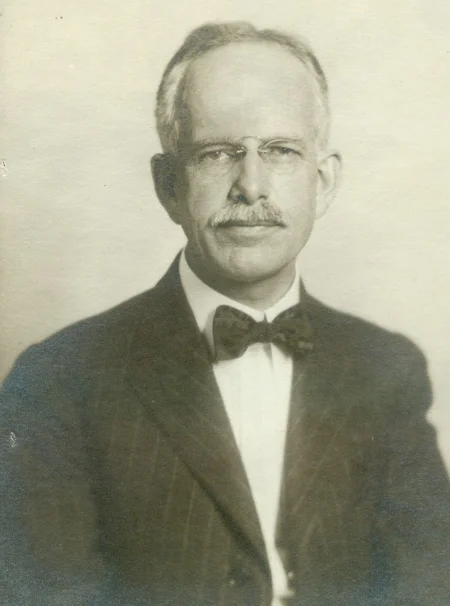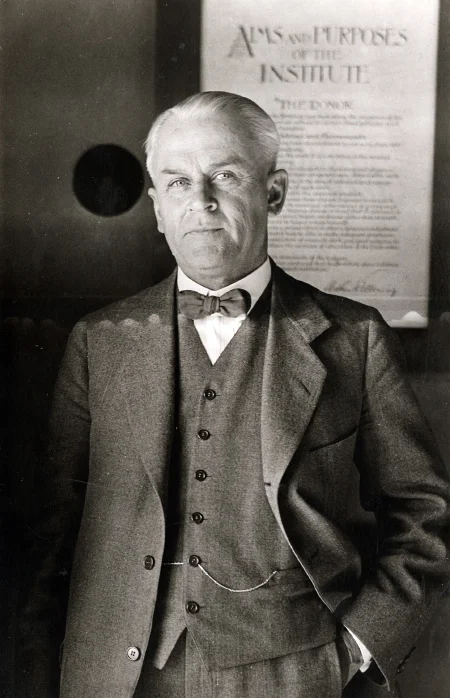A Sesquicentennial Salute
To George Ellery Hale and Robert A. Millikan
This spring marks the 150th anniversary of the births of two of the Institute’s founders, George Ellery Hale and Robert Andrews Millikan. In their honor—and also to acknowledge Caltech’s third founder, Arthur Amos Noyes, who would have turned 150 years old in 2016—we remember their critical roles in establishing the Institute and their remarkable scientific achievements.
In this article excerpt, Judith Goodstein, Caltech’s archivist for 41 years, tells the story of the early years of the Institute, when this troika of visionaries set the stage for a future of innovation and ambition on California Boulevard.
Caltech’s beginnings are rooted in a modest little college founded in Pasadena in 1891 by wealthy former abolitionist and Chicago politician Amos Throop. Initially named Throop University, the school changed its name to Throop Polytechnic Institute in 1893. In its first 15 years, Throop served the local community, teaching a great variety of subjects, from arts and crafts to zoology, with considerable emphasis on vocational training. By 1906, Throop needed a fresh sense of purpose. The American astronomer George Ellery Hale, the first director of the nearby Mount Wilson Observatory and a newcomer to Pasadena, would provide it.
A scientist bubbling over with educational, architectural, and civic ideas, Hale was elected to the school’s board of trustees in 1907 and promptly set about to transform it. He persuaded school officials to abandon Throop’s high school and other programs and concentrate on expanding and developing the college along engineering lines; recruited James A. B. Scherer, who served as Throop’s president between 1908 and 1920; and enticed Arthur A. Noyes, former president of MIT and the nation’s leading physical chemist, to join him in Pasadena. In Noyes, Hale saw not only an opportunity to bring chemistry at Throop College (Throop officially changed its name to Throop College of Technology in 1913) up to a level with that at MIT but also to put Throop itself in the national limelight. The third member of Hale’s scientific troika was the physicist Robert A. Millikan, who began, in 1917, to spend several months a year at Throop as director of physical research.
The three of them spent the World War I years in Washington, organizing and recruiting scientists to work on military problems, but also building a superb network of contacts that would later serve the school well. Collectively ambitious for American science, eager to see their country play a larger role on the world’s scientific stage, and determined to put Throop on the map, Hale, Millikan, and Noyes had become a formidable scientific triumvirate by 1918. By Armistice Day, they had set the stage to transform the engineering school into an institution that put pure science first.
Between 1919 and 1921, the school obtained a handsome endowment, drafted a new educational philosophy, took its present name, and selected a new man to guide its destiny for the next 25 years. Hale and Noyes wanted to use Caltech to reshape the education of scientists. Millikan wanted to make Caltech one of the physics capitals of the world. To do that, he needed research funds.
The three men came to an agreement. Hale and Noyes promised Millikan the lion’s share of the school’s financial resources and minimal administrative duties as head of the Institute. In return, Millikan agreed to come as director of the Norman Bridge Laboratory of Physics and administrative head of the Institute. By then, Noyes had resigned from MIT and accepted a full-time appointment as director of chemical research in Pasadena.
“The History of Caltech” was first published on the Nobel Prize website, nobelprize.org.
George Ellery Hale
Invented the spectroheliograph, an instrument for taking pictures of gaseous eruptions on the sun. The instrument was housed at an observatory built for him by his father near their home.
Founded The Astrophysical Journal in 1894—today’s premier publication for astronomy research.
Built the world’s largest telescope at the time, a 40- inch refractor telescope in Wisconsin, operated by the University of Chicago. Along with the telescope, which opened in 1897, he built the attached Yerkes Observatory, a laboratory space for other related research.
Helped establish the American Astronomical Society in 1899.
Climbed Mount Wilson in 1903 with two other astronomers, realizing its potential to revolutionize our views of the universe.
For a second time, built the world’s largest telescope, a 60-inch reflector lens at Mount Wilson, which opened in 1908.
For a third time, built the world’s largest telescope—the 100-inch Hooker Telescope at Mount Wilson—which, delayed by World War I, finally became operational in 1918.
For a fourth time, orchestrated the building of the world’s largest telescope, a 200-inch mirror at the Palomar Observatory. It saw “first light” in 1949, 11 years after Hale died. It remained the world’s largest telescope until 1975 when the Russian BTA-6 saw first light.
Worked with Henry E. Huntington, a railcar magnate who had a collection of rare books and paintings, to create The Huntington Library, Art Collections and Botanical Gardens.
“Like buried treasures, the outposts of the Universe have beckoned to the adventurous from immemorial times. Princes and potentates, political or industrial, equally with men of science, have felt the lure of the uncharted seas of space, and through their provision of instrumental means the sphere of exploration has rapidly widened. … Each expedition into remoter space has made new discoveries and brought back permanent additions to our knowledge of the heavens.”
“Hale helped turn Pasadena from a sleepy town best known for its orange groves and as a place of winter residence into the thriving scientific and cultural center it is today. He had a remarkable ability to get funding for projects and keep them on budget. It’s hard to fathom how much he did in his lifetime.”
Robert Andrews Millikan
A fine athlete and talented boxer, Millikan considered a career in physical education while at Oberlin College.
- Became the first student, in 1895, to receive a PhD from the physics department at Columbia University.
- Started, in 1907, the first of two experiments to measure the charge of the electron by balancing the gravitational and electrical forces acting on charged water droplets.
- Demonstrated that an electric charge always occurs as an integer multiple of a basic unit (the electron charge), which he measured accurately.
- Published his results in 1910, which were contested by Austrian physicist Felix Ehrenhaft. In 1913, Millikan settled the issue, publishing accurate results from a greatly improved experiment where he replaced water (which evaporated too quickly) with oil.
- Beginning in 1915, worked to verify Einstein’s theory of the photoelectric effect (the emission of electrons by a conductor struck by light), by which the maximum energy of ejected electrons is proportional to the individual energy of incident photons, a manifestation of the particle-like nature of light.
- Awarded the 1923 Nobel Prize “for his work on the elementary charge of electricity and on the photoelectric effect.”
At Caltech, undertook a major study of radiation from outer space. Millikan proved that this radiation is indeed of extraterrestrial origin, and he named it “cosmic rays.”
Served as vice chairman of the National Research Council and helped to develop anti-submarine and meteorological devices during World War I.
“I suspect that the changes that have taken place during the last century in the average man’s fundamental beliefs, in his philosophy, in his concept of religion, in his whole world outlook, are greater than the changes that occurred during the preceding four thousand years all put together. ... [S]cience and its applications to human life ... have bloomed in my time as no one in history had ever dreamed could be possible.”
“I think that Millikan was an extraordinarily great person in so many different ways: As a physicist, doing physics; as an administrator, doing more than ordinary administration— actually building a new institution from essentially nothing, which meant getting money, for one thing, and getting people; and being a good enough promoter, or advertising agent if you like, to put Caltech on the map.”
Related story: Aziz Inan, a professor of electrical engineering at the University of Portland, submitted "15 Numerical Oddities for Robert Millikan’s 150th Birthday"



